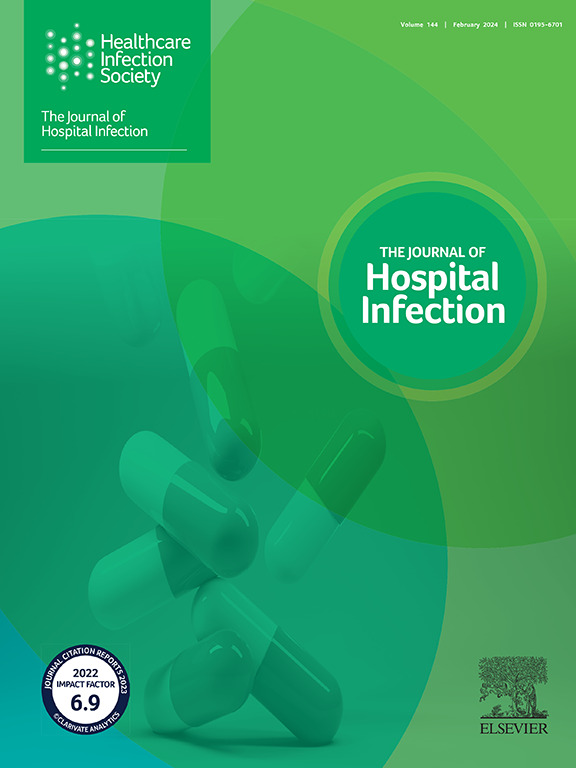The Omicron variant significantly increases viral load emissions in healthcare settings: implication for healthcare workers
IF 3.1
3区 医学
Q1 INFECTIOUS DISEASES
引用次数: 0
Abstract
Background
The SARS-CoV-2 Omicron variant is transmitted via contaminated droplets and aerosols, raising concerns in healthcare settings where poor ventilation and high patient density can increase airborne viral load.
Aim
This study aimed to assess real-world exposure of healthcare workers to COVID-19-positive patients isolated in designated hospital areas, using continuous 24-h air sampling.
Methods
Air sampling was conducted inside 10 hospital rooms hosting a succession of 38 patients who tested positive for SARS-CoV-2. Sampling was performed using 37-mm cassettes placed near the patients' heads. The Omicron variant in the air was detected by RT-qPCR, with results expressed as emission rates based on air changes per hour for each room and correlated with the onset of patients' symptoms.
Findings
The SARS-CoV-2 was detected and quantified in the air of 89% of patients, indicating that 76.7% of the rooms hosting positive patients had detectable levels of airborne virus. This corresponded to an average viral emission rate of 1.45 × 105 ± 2.16 × 105 genomes/h per patient. Expectoration was the sole symptom significantly affecting emission rates, with patient suffering from it exhibiting values three times higher than patients without. Additionally, the room accounted for half of the variance in emission rates, suggesting that the number of patients and the room's prior usage are key determinants of viral particle exposure.
Conclusion
Our findings indicate that healthcare workers face significant exposure when providing care in rooms with positive patients, even when mechanically ventilated. Greater attention should be given to treating and managing these spaces to reduce the potential for viral transmission toward healthcare workers.
欧米克隆变异显著增加了医疗环境中的病毒载量排放:对医疗工作者的启示。
SARS-CoV-2 Omicron变体通过受污染的飞沫和气溶胶传播,这在通风不良和患者密度高可能增加空气传播病毒载量的医疗机构引起了人们的担忧。本研究通过连续24小时空气采样,评估了卫生保健工作者在指定医院区域隔离的COVID-19阳性患者的真实暴露情况。在10个病房内进行了空气采样,这些病房连续容纳了38名SARS-CoV-2检测呈阳性的患者。使用放置在患者头部附近的37毫米盒式磁带进行采样。通过RT-qPCR检测空气中的Omicron变体,结果表示为基于每个房间每小时换气量的排放率,并与患者症状的发作相关。在89%的患者的空气中检测到SARS-CoV-2并进行了量化,表明76.7%的阳性患者所在的房间空气中可检测到病毒水平。这相当于平均病毒发射率为1.45×105±2.16×105基因组/小时/患者。排痰是唯一显著影响排痰率的症状,患有排痰的患者的排痰率是没有排痰的患者的三倍。此外,房间占排放率差异的一半,这表明患者人数和房间先前的使用情况是病毒颗粒暴露的关键决定因素。我们的研究结果表明,在有阳性患者的房间提供护理时,卫生保健工作者面临着显著的暴露,即使在机械通风的情况下也是如此。应更加重视对这些空间的治疗和管理,以减少病毒向医护人员传播的可能性。
本文章由计算机程序翻译,如有差异,请以英文原文为准。
求助全文
约1分钟内获得全文
求助全文
来源期刊

Journal of Hospital Infection
医学-传染病学
CiteScore
12.70
自引率
5.80%
发文量
271
审稿时长
19 days
期刊介绍:
The Journal of Hospital Infection is the editorially independent scientific publication of the Healthcare Infection Society. The aim of the Journal is to publish high quality research and information relating to infection prevention and control that is relevant to an international audience.
The Journal welcomes submissions that relate to all aspects of infection prevention and control in healthcare settings. This includes submissions that:
provide new insight into the epidemiology, surveillance, or prevention and control of healthcare-associated infections and antimicrobial resistance in healthcare settings;
provide new insight into cleaning, disinfection and decontamination;
provide new insight into the design of healthcare premises;
describe novel aspects of outbreaks of infection;
throw light on techniques for effective antimicrobial stewardship;
describe novel techniques (laboratory-based or point of care) for the detection of infection or antimicrobial resistance in the healthcare setting, particularly if these can be used to facilitate infection prevention and control;
improve understanding of the motivations of safe healthcare behaviour, or describe techniques for achieving behavioural and cultural change;
improve understanding of the use of IT systems in infection surveillance and prevention and control.
 求助内容:
求助内容: 应助结果提醒方式:
应助结果提醒方式:


